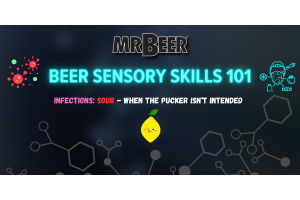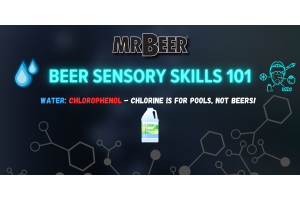How to Make Non-Alcoholic Beer

Alright, that is it! If I had a dollar for every time, I was asked about making NA homebrew, I could buy a lot of commercial NA beer! Seriously though, it comes up ALL THE TIME, so I thought, “ya know what? Let’s just go ahead and oblige these fine people, already.” So here we stand; you excited? Don’t answer that or do if the answer is “yes”. Moving right along… heh, heh, heh.
What you may not know is that most NA beer starts as “regular” beer containing alcohol. That means that your average Mr. Beer Refill can indeed be made nearly alcohol-free. Before I get into the how there are a couple of things you need to know. The first thing is that alcohol is more volatile than other liquids and because of that, slow and long heating is typically the easiest method for alcohol removal from fermented beer. The next thing you need to know about making good quality NA homebrew is “all-malt” is better than trying to remove alcohol from a beer that is more adjunct heavy. We recommend reaching for a deluxe refill, HME can only, or a complete craft refill, with no Boosters.
Why? Well, because we aren’t after alcohol production, we are after FLAVOR. Speaking of flavor, the next thing you need to ponder is your water quality. This becomes VERY important when dealing with any beer but NA beer especially… Alcohol covers up more than you think, so make sure you are using chemical-free (hello Chloramine) drinking water! Sticking with all malt options will also help shorten the evaporation process later and leave you with more “beer” flavor.
So now that we have selected the appropriate refill, what next? Well, you brew and ferment that beer just as you would any wort! It is what we do AFTER fermentation is complete that makes it non-alcoholic. From here, I will break down the process from start to finish, below.
For the Alcohol removal process, you will need a large, clean pot that will fit the entire volume of your beer, and a controllable heat source (stove) as well as a thermometer.
Gently flow the fermented beer, ideally via tubing to reduce any splashing, into the large, clean pot.
Insert your thermometer and begin gently heating the beer (you can stir it very occasionally with a sanitized spoon to help keep the heat even, but do not agitate the beer)
Watch the temperature very carefully, do not allow it to exceed 175 degrees Fahrenheit and should stay closer to 173. You will maintain this temperature, allowing the alcohol to evaporate for about 20-30 minutes. To determine if you are done, a sample can be cooled and a hydrometer used, but it’s honestly a lot easier to designate a taste tester if you cannot taste the beer yourself.
Temperature maintenance is key here, so watch that temp closely… If you creep too high, you can get some not-so-nice-off flavors!!
Once you have evaporated the alcohol from your beer. The solution will need to cool. You can use a wort chiller or ice water bath, but the less agitation you create in the beer the better, so leaving it to cool is fine too. Avoid covering it as this can create condensation under the lid from steam, which will potentially dilute your flavors.
Now that your beer has had its NA treatment… it is going to be really, really flat and probably kind of one noted, flavor-wise. Don’t worry! We have bottle conditioning up our sleeve.
Before we get into that… Have you ever noticed that most NA beer still contains .5% alcohol? Usually, this is due to bottle conditioning. Using this process, however, is a big part of what makes NA beer, taste anything like “regular” beer. So, it is best not to skip it.
Once your beer has cooled enough to not kill the yeast cells you are going to be adding, it is ready to bottle! For this, you will need carb drops or table sugar for bottle priming and you will conduct that normally with one addition… A pinch of yeast to each bottle! Once your beer has cooled enough you can transfer it back to the LBK for botting. (make sure it’s sanitized).
It’s a good idea to stick with the same yeast you used in the fermentation for this as well. Sanitize and dry a small saucer or plate and empty a small Cooper’s gold yeast packet into the center of the dish. Wash and dry your hands very well. After you add carb drops or sugar and fill each bottle with beer, press the tip of your clean finger into the yeast on the plate and add whatever cells that stick to your finger (it’s usually plenty if there’s a fairly even layer on the fingertip) and sprinkle them over the beer in each bottle, seal the caps and allow them to condition at room temperature for 3 weeks before enjoying. While doing this, I think it’s best to work one bottle at a time, Prime, fill, yeast, cap. Repeat with the next bottle.
As you can see, with a little extra work you CAN have NA homebrewed beer! If you decide to give this a whirl, just remember to stick with REFILLS that do not contain a booster addition (Use Deluxe, HME can only or complete craft options instead) and not “Recipes” as these may not lend themselves very well to the reheating process. As always, if you have questions about this or any other beer-related topic, never hesitate to reach out to us at the helpdesk!
Cheers!
Ashley





